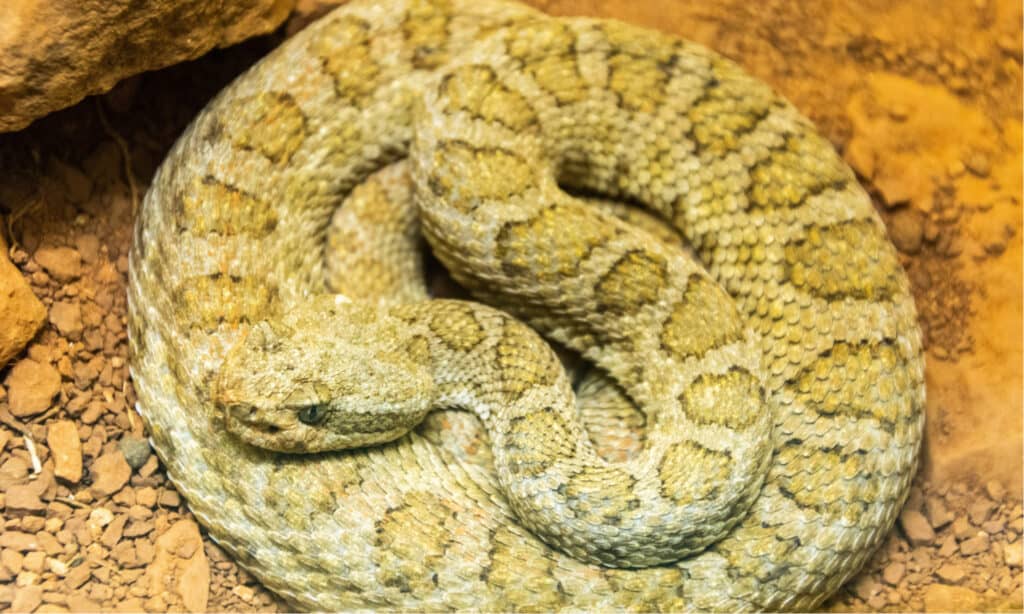Midget Faded Rattlesnake
.jumbotron {
background-image: url(“https://a-z-animals.com/media/2022/04/crotalus-concolor-midget-shutterstock_644472529-400×300.jpg”);
}
}
@media only screen and (min-width: 641px) and (max-width: 920px) {
.jumbotron {
background-image: url(“https://a-z-animals.com/media/2022/04/crotalus-concolor-midget-shutterstock_644472529-470×370.jpg”);
}
}
@media only screen and (min-width: 921px) {
.jumbotron {
background-image: url(“https://a-z-animals.com/media/2022/04/crotalus-concolor-midget-shutterstock_644472529.jpg”);
}
}
Midget Faded Rattlesnake
C. concolor
They’re also called horseshoe rattlesnakes thanks to the shape of their markings.
Midget Faded Rattlesnake Scientific Classification
- Kingdom
- Animalia
- Phylum
- Chordata
- Class
- Reptilia
- Order
- Squamata
- Family
- Viperidae
- Genus
- Crotalus
- Scientific Name
- C. concolor
Read our Complete Guide to Classification of Animals.
Midget Faded Rattlesnake Conservation Status
Midget Faded Rattlesnake Facts
- Prey
- small mammals, lizards, birds
- Name Of Young
- Neonate
- Group Behavior
-
- Mainly solitary
- Communal Dens
- Fun Fact
- They’re also called horseshoe rattlesnakes thanks to the shape of their markings.
- Biggest Threat
- Human encounters
- Most Distinctive Feature
- Generally faded coloration in the adults.
- Distinctive Feature
- Rattle
- Other Name(s)
- Horseshoe rattlesnake, yellow rattlesnake, faded rattlesnake
- Gestation Period
- 4 months
- Temperament
- Mellow, non-aggressive
- Litter Size
- 3-5
- Habitat
- rock outcrops, sagebrush, high desert.
- Predators
- owls, hawks, coyotes
- Diet
- Carnivore
- Lifestyle
-
- Diurnal
- Crepuscular
- Favorite Food
- mice
- Migratory
- 1
Midget Faded Rattlesnake Physical Characteristics
- Color
-
- Brown
- Grey
- Yellow
- Silver
- Skin Type
- Scales
- Venomous
- Yes
- Aggression
- Low
This post may contain affiliate links to our partners like Chewy, Amazon, and others. Purchasing through these helps us further the A-Z Animals mission to educate about the world’s species..

Discover alligator-eating snakes, spiders larger than your phone, and 1000 more incredible animals in our daily FREE email.
.photo-gallery {
–margin: 0px auto 0px;
–padding: 0px 0px 0px 0px;
}
.gallery-link {
background-image: url(“https://a-z-animals.com/media/2022/04/crotalus-concolor-midget-shutterstock_1280022160-1024×614.jpg”);
background-repeat: no-repeat;
background-size: cover;
background-position: center;
height: 500px;
justify-content: center;
text-align: center;
align-items: center;
display: flex;
border: 2px solid #000;
}
.gallery-link img {
height: 50%;
}
@media only screen and (max-width: 768px) {
.gallery-link {
height: 300px !important;
}
}
View all of the Midget Faded Rattlesnake images!
The Midget faded rattlesnake is one of the most venomous rattlesnake species.
These diminutive rattlesnakes hide in crevices and under scrub-brush, waiting for their next meal. Midget faded rattlesnakes live in the Colorado and Green River basins, where their sand-colored bodies and faded patterns perfectly conceal them from predators and prey alike.
3 Amazing Facts About Midget Faded Rattlesnakes
- Unlike most rattlesnakes, midget faded rattlesnake venom contains a neurotoxin that affects the nervous system and a myotoxin that destroys muscle tissue.
- This species doesn’t typically exceed 2 1/2 feet in length, and most are around two feet long.
- Females use communal thermoregulation, sharing basking spots and dens until they give birth.
Where to Find Midget Faded Rattlesnakes
This snake inhabits a limited area in the Colorado and Green River basins in Wyoming, Colorado, Utah, and possibly a very small area in northeast Arizona. It inhabits high elevation canyons in those states and has a short period of activity each year. While not extremely rare, midget faded rattlesnakes are vulnerable to habitat destruction for infrastructure development, illegal pet trade collection, and recreational vehicles.
button.pulse {
transform: scale(1); animation: pulse 2s infinite;
box-shadow: 0 0 0 0 rgba(11, 247, 25, 1);
}
@keyframes pulse {
0% { transform: scale(0.90); box-shadow: 0 0 0 0 rgba(11, 247, 25, 0.5); }
60% { transform: scale(1); box-shadow: 0 0 0 15px rgba(11, 247, 25, 0); }
100% { transform: scale(0.90); box-shadow: 0 0 0 0 rgba(11, 247, 25, 0); }
}
The midget faded rattlesnake uses its den more heavily than other rattlesnake species. In October and November, the snake travels to its communal den for several months of hibernation. Because of the long cold season in its home range, it can spend six months of the year hibernating in groups of up to 100, using dens created by rocky outcrops where sage is prevalent.
Then, when the days lengthen and warm, it comes out to bask, eat, and mate.
In April or May, depending upon temperatures, this snake comes out of hibernation. It most often doesn’t leave the hibernaculum for two to three weeks; males and non-pregnant females travel the farthest, often moving up to 2,200 yards from their den. This is the longest migration of any rattlesnake species. Pregnant or postpartum females and juvenile snakes generally stay within about 20 yards of the den.
Females mate every two to four years and when they are pregnant stay very close to the den in which they hibernate, sharing basking space with other females. After about 4 months, they give birth to approximately 5 babies that are between 7.5 and 8.5 inches long.
This species is a generalist that prefers lizards and smaller rodents until it grows big enough to swallow mice and other rodents. It spends most of its time waiting for its prey so it can ambush it with a quick strike. After the snake strikes its prey, it follows until the venom takes its deadly toll and the rattlesnake can swallow it whole.
Midget Faded Rattlesnakes’ Scientific Name
Until about the early 2000s, scientists classified midget faded rattlesnakes as a subspecies of the western rattlesnake. Genetic, morphologic, and toxin studies revealed that they are a true species on their own and now their scientific name now reflects this.
Crotalus concolor is their scientific name, and it describes this species as a plain or consistently-colored (concolor) rattle (Crotalus). While concolor isn’t an entirely accurate description, the adults’ markings do become very faded as they age.
Midget faded rattlesnakes are pitvipers in the subfamily of Crotalinae. They are one of over 30 rattlesnake species, all of which inhabit the Americas; scientists consider them one of the more venomous rattlesnake species.
Population and Conservation Status of Midget Faded Rattlesnakes
Midget faded rattlesnakes are most vulnerable to human expansion, whether it’s infrastructure development like roads or energy development. So far they appear to be stable, and they’re not listed at a federal level. However, due to their general rarity, the states in which they occur have protected them.
This highly specialized species inhabits areas that are regularly used for recreation; mountain bikers, hikers, and off-road enthusiasts are more likely to encounter one than anyone else. However, energy companies also want to use the areas where the snake lives for energy development.
To help balance the need for more energy with the snake’s preservation, Wyoming sponsored a study to model the species’ denning and behavioral habits. This study suggested that the midget faded rattlesnake population is becoming fragmented, limiting the genetic diversity.
Scientists know relatively little about its actual population despite efforts to preserve the species. They’re notoriously difficult to observe and blend into their environment so well that you may be standing next to one and not see it. It’s rare enough that Colorado considers it a Species of Special Concern. Wyoming calls it a Sensitive Species, and Utah includes it in its list of Species of Greatest Conservation Need.
Midget Faded Rattlesnake Appearance & Description
Like other rattlesnakes, midget faded rattlesnakes are pitvipers and have heat-sensing organs called loreal pits between their nostrils and eyes. Their pupils are elliptical, and their eyes are hooded with an extra scale. Most individuals of this species are around 24 inches long, but sometimes one will reach 30 inches in length.
They have dark stripes extending back from their eyes, downward towards the back of their mouths, and dark-ringed liver-shaped dorsal (back) blotches. These snakes have a light brown base color (almost like that of beach sand), but can also be yellow, peach, or reddish. Their dorsal patterns are often difficult or impossible to see in older individuals, but this species is born with vivid markings that fade as the snake matures. Midget faded rattlesnakes have dark-rimmed blotches on their backs that almost become bands towards the tail which ends in a rattle. They also have blotches on their sides which aren’t always outlined.

Rusty Dodson/Shutterstock.com
Pictures and Videos of Midget Faded Rattlesnakes

Alizada Studios/Shutterstock.com
Venom: How Dangerous is the Midget Faded Rattlesnakes
According to Wyoming Fish & Game, faded midget rattlesnakes are one of the most dangerous of all rattlesnakes. The LD50 of their venom suggests it is more toxic than a few of the Old World cobras. This being the case, they have some potent venom.
Midget faded rattlesnakes carry concolor toxin, a neurotoxin unique to the species, and a potent myotoxin. Interestingly, even though their preferred prey changes as they mature, these snakes’ venom toxicity doesn’t appear to change.
Wyoming Fish and Game rightly points out that most bites occur because the individual did something to the snake. This is not an aggressive species and the general public has no business handling it. A bite from one will send you to the hospital. While this snake is small for a rattlesnake, its venom is highly toxic, and symptoms of envenomation can include intense pain, swelling, blistering, nausea, and vomiting.
Midget Faded Rattlesnakes Behavior and Humans
This shy little rattlesnake hides in crevices created by rock outcrops and under sagebrush. They’re exclusively found in the Green River Formation, which extends across Colorado, Wyoming, and Utah. There’s some speculation that there could be a population of midget faded rattlesnakes in far northeast Arizona, but it’s not confirmed.
Unless you’re out exploring Moab or other similarly remote areas, you’re unlikely to ever see one. Even so, they’re so reclusive that you could be standing near one and not know it. This species does rattle but is more likely to use its excellent camouflage to stay hidden.
Still, if you encounter one of these rare reptiles, give it some space and it will happily go along its way without bothering you.
View all 114 animals that start with M
Midget Faded Rattlesnake FAQs (Frequently Asked Questions)
Are midget faded rattlesnakes venomous?
Yes, and studies suggest that its venom may even be more dangerous than that of some of the Old World Cobras.
What do midget faded rattlesnakes eat?
These snakes eat a variety of small prey animals: lizards, mice, birds are all included in its diet.
How do midget faded rattlesnakes hunt?
This species is an ambush predator, and will often spend several hours or days in one place waiting for something to wander past.
Are midget faded rattlesnakes aggressive?
No, like most snake species, this one does not want to mess with you. Given a chance, it will choose escape over fighting, and many say that you have to work hard to get this one to strike.
Sources
- Midget Faded Rattlesnake Bite | DovMed, Available here: https://www.dovemed.com/diseases-conditions/midget-faded-rattlesnake-bite/
- Save the Buzztails, Available here: https://www.savethebuzztails.org/species-accounts/Midget-Faded-Rattlesnake
- Wyoming Fish & Game, Available here: https://wgfd.wyo.gov/WGFD/media/content/PDF/Habitat/SWAP/Reptiles/Midget-Faded-Rattlesnake.pdf
- Colorado Partners in Amphibian and Reptile Conservation (COPARC), Available here: http://www.coparc.org/midget-faded-rattlesnake.html
- Orianne Society, Available here: https://www.oriannesociety.org/uncategorized/midget-faded/?v=400b9db48e62
- Utah Species of Greatest Conservation Need List, Available here: https://wildlife.utah.gov/pdf/WAP/2021-10-sgcn-list.pdf
- CONSERVATION AND MANAGEMENT OF MIDGET FADED RATTLESNAKES STATE WILDLIFE GRANT , Available here: https://www.oriannesociety.org/sites/default/files/Conservation%20and%20Management%20of%20Midget%20Faded%20Rattlesnakes%20_Final%20Report_Web.pdf
- Wyoming Fish & Game, Available here: https://wgfd.wyo.gov/Regional-Offices/Green-River-Region/Critter-Spotlight/Midget-faded-rattlesnake
















